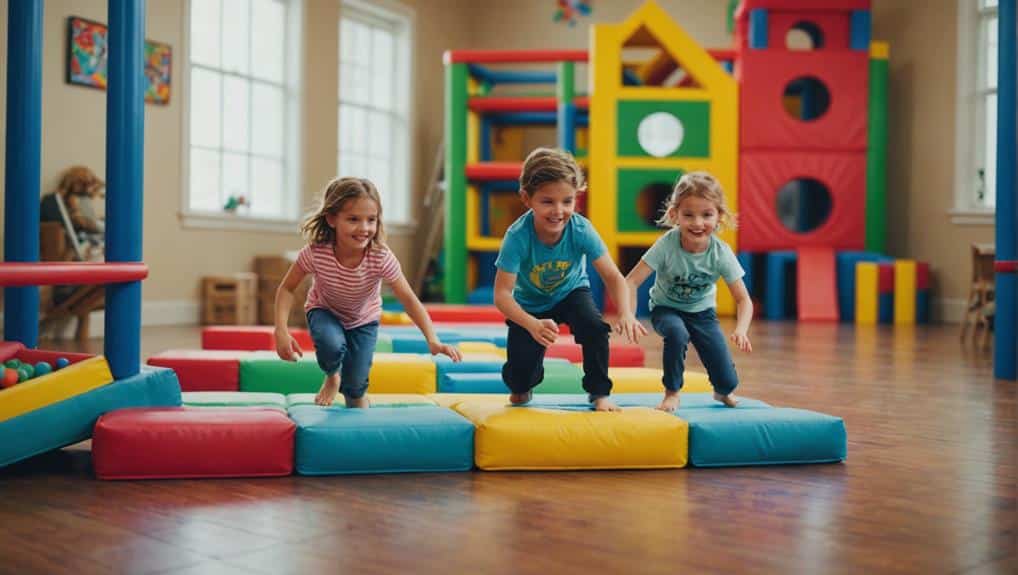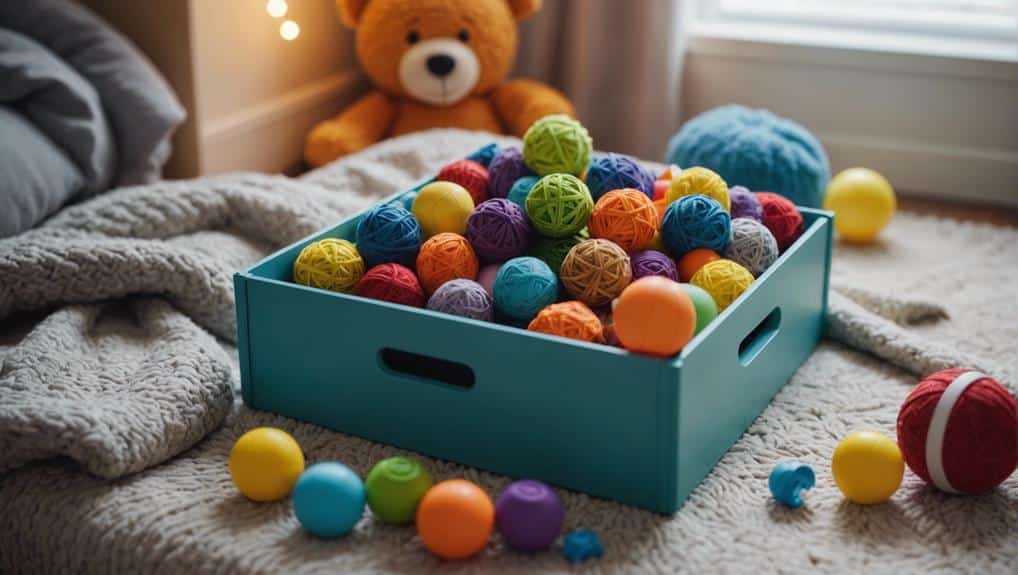Calming your child through sensory solutions can make a big difference. Please set up an action room with various swings to help regulate their sensory needs. Create an obstacle course using household items to develop their motor and cognitive skills. Play catch to improve hand-eye coordination and focus. A break box with sensory tools like stress balls can help them manage emotions and stay focused. Integrating these activities into their routine offers physical and mental benefits, providing comfort and fostering development. For more detailed strategies that are easy to implement, you’ll find additional helpful ideas.
Key Takeaways
- Create an action room with various swings to regulate sensory needs and provide calming effects.
- Use vestibular movements like swinging or rocking to calm an overactive mind.
- Design an indoor obstacle course to enhance balance, coordination, and motor skills.
- Play catch to improve hand-eye coordination and sensory processing abilities.
- Make a break box with sensory tools like stress balls and fidget spinners for self-regulation.
Set Up an Action Room
Creating an action room with various swings can frequently help your child regulate their sensory needs effectively. When your child engages in swinging or rocking movements, it can profoundly impact their nervous system. These activities can calm an overactive brain and provide a soothing, normalizing effect. Installing a doorway bar swing, ceiling suspension swing, or even an outdoor swing set offers your child multiple options to receive beneficial sensory input.
Active swings, like strap swings or trapeze bar swings, require physical effort. This engagement in physical activity helps to integrate motion and provides a calming effect on your child’s sensory system. Swinging back and forth can become a delightful routine that helps regulate their nervous system, making it easier for them to manage their emotions and energy levels.
An action room dedicated to these activities can serve as a sanctuary where your child feels understood and supported. It’s a space where they can engage in physical activity while remaining calm. This tailored environment fosters a sense of belonging and safety, meeting their sensory needs in a powerful, evidence-based way.
Calm the Brain
To calm your child’s brain, consider incorporating vestibular movements like swinging or rocking into their daily routine. These activities can help regulate sensory input, providing a soothing effect for an overactive mind. Swinging back and forth, whether on a doorway bar swing, ceiling suspension swing, or outdoor swing set, integrates motion that can normalize brain activity and calm your child effectively.
Active swings, such as a strap swing or trapeze bar swing, require physical effort, which engages the brain in a focused, calming way. This sensory input is especially beneficial for children with sensory processing challenges, helping them unwind and relax after a stimulating day.
Create an Obstacle Course

Have you considered transforming your living room into an exciting obstacle course to help your child develop essential physical and cognitive skills? Creating an obstacle course using everyday items like chairs, footstools, and hula hoops can be an engaging and beneficial activity for your child’s sensory processing. By placing these items one foot or two apart, you challenge your child to navigate over, under, and around them, offering a thorough physical workout.
Here’s how to set up your obstacle course:
- Chairs and Footstools: Arrange them in a line to crawl under or climb over.
- Hula Hoops: Lay them on the floor as targets for jumping or hopping.
- Pillows and Blankets: Use them to create tunnels or soft areas for balancing.
Engaging in the obstacle course for just 10 minutes can significantly enhance your child’s direction, balance, and coordination skills. This fun and interactive activity stimulates the brain, promoting physical movement and spatial awareness. Not only will your child improve their motor skills and concentration levels, but they’ll also feel a sense of accomplishment and belonging. As they navigate the course, they’re learning to process sensory information more effectively, which is vital for overall development.
Play Catch
Playing catch with your child isn’t just enjoyable but galvanically enhances their hand-eye coordination and cognitive skills. This simple activity offers a wealth of benefits that go beyond just having fun. When you play catch, you’re helping your child develop their organizational skills and focus, which are essential for their growth. Catching a ball requires concentration and attention, which can improve your child’s sensory processing abilities.
Introducing different types of balls, like tennis balls or beach balls, adds variety and keeps the activity enjoyable. Switching hands for tossing and catching engages both sides of the brain, promoting better cognitive development. This bilateral coordination is crucial for overall brain function and can be especially helpful for children who need support in these areas.
Incorporating catch into your daily routines can be an excellent way to keep your child active and engaged. It’s not just about physical exercise; it’s also about building a stronger connection with your child. Making catch a regular part of your day fosters a sense of belonging and security, vital for your child’s well-being.
Make a Break Box

Creating a break box filled with sensory tools like stress balls and fidget toys can be an effective way to help your child regulate their emotions and stay focused. This tactile outlet enables kids to manipulate and touch objects, aiding concentration and sensory processing.
Here are three items to include in your break box:
- Stress Balls: These provide a satisfying squeeze to help your child release pent-up energy and reduce anxiety.
- Fidget Spinners: These help maintain focus and keep hands busy, promoting organized neural pathways in the brain.
- Soft Fabric Squares: Different textures can offer soothing sensations, enhancing your child’s self-regulating ability.
Incorporating a break box into your child’s routine is more than just a fun activity; it’s a proactive strategy to manage sensory meltdowns and promote self-regulation. Whether your child uses it before, during, or after homework, the break box can help them stay engaged and on task. When children fidget with items in the box, they create organized neural pathways, which leads to better sensory processing. By providing these tools, you’re offering a sense of belonging and understanding, showing your child that their needs are recognized and supported.
Frequently Asked Questions
How Do You Calm Down a Child With Sensory Processing Disorder?
To calm a child with Sensory Processing Disorder, utilize deep pressure tools, engage in proprioceptive activities, and decrease auditory stimuli with noise-canceling headphones. Develop a sensory diet plan and provide regular sensory breaks to maintain regulation.
What Are Some Sensory Solutions for Children?
When your child needs a moment of tranquility, consider swinging activities, chill spa setups, or obstacle courses. Playing catch or using a break box with sensory tools can also provide the calm they seek.
What Is a Calming Input for Kids?
Calming input for kids can include vestibular movement like swinging. You can install doorway bar swings or ceiling suspension swings for soothing motion. These help regulate emotions, providing your child with a sense of security and connection.
How to Discipline a Child With Sensory Issues?
Remember that actions speak louder than words when disciplining a child with sensory issues. Use consistent routines, clear expectations, and positive reinforcement. Create a calm environment, and seek professional guidance for tailored strategies.
Conclusion
Children with sensory processing difficulties, such as those with autism spectrum disorder, can benefit from specific strategies to manage their sensory needs. Creating a designated space for calming activities, incorporating body-awareness techniques, and providing sensory input through activities like playing catch or navigating an obstacle course can be helpful. These evidence-based, child-centered strategies can make a meaningful impact on daily life.
Understanding that every child is unique is essential, and an empathetic approach can make a difference in their world. By consistently implementing these sensory strategies, the child can develop self-regulation skills over time, positively impacting their reactions to sensory stimuli.
Remember, children with sensory processing issues may have sensitivities to certain sensory stimuli, so techniques like deep pressure therapy, joint compressions, or weighted vests can aid in self-calming. It’s essential to consult with professionals, such as pediatric occupational therapists, to develop an individualized plan that best suits the child’s needs.


Recent Comments